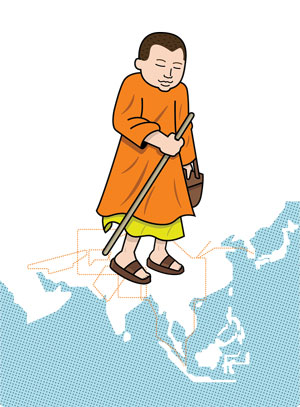Renowned Buddhist studies professor Donald S. Lopez Jr. cites Italo Calvino’s novel Invisible Cities as one inspiration for the book Hyecho’s Journey: The World of Buddhism. However, unlike Calvino’s masterpiece, which imagines Marco Polo describing fictitious cities to Kublai Khan, Hyecho’s Journey shows us how real cities might have appeared to an 18-year-old Korean monk on pilgrimage to the major Buddhist sites of the 8th century. The book draws on traditional Buddhist imagination, as expressed in depictions of the Buddha’s life and world in narrative and art.
Hyecho’s Journey, which stands alone as a gorgeously produced scholarly excursion through Buddhist story and image-craft, is also an artifact in a multimedia project that features an extensive exhibition at the Freer|Sackler Galleries in Washington, DC, and includes an iPhone app developed by students. The book was created by the Humanites Collaboratory, a team of scholars led by Lopez at the University of Michigan. (Their work was funded by the Provost of the University of Michigan, who has encouraged teamwork in the humanities along a model frequently used in the sciences.) The Hyecho’s Journey team was made up of professors and scholars in the fields of art history (Kevin Carr, Rebecca Bloom, Chun Wa Chan); South Asian archaeology (Carla Sinopoli); and Korean Buddhism (Ha Nul Jun), and from the university’s Asia Library (Keiko Yokota-Carter). Lopez called their project “an exercise in collective imagination.”

Hyecho’s Journey follows the young monk on his journey from Korea by sea to China and India, and then to Central Asia, before returning overland to China. Pilgrimages to the land of the Buddha’s birth were common among Buddhists then as now, though travel in the 8th century was far more treacherous than it is today. Remarkably, Hyecho completed his journey in only three years, covering more ground in less time than any other early Asian pilgrim who left a record. Unlike the diaries and records of the famous monk-pilgrims Xuanzang (c. 602–664 CE) and Yijing (635–713 CE), who left a legacy of knowledge about their visits and hundreds of translated Buddhist texts, Hyecho’s travel notes and poems, written in poor Chinese, were found in 1908 in Dunhuang in the form of fragments. Hyecho’s writings offer few details about his experience, and leave more questions than answers. As Lopez told Tricycle, it’s that very lack of detail that allows Hyecho to act as an “avatar” that readers can inhabit, imagining, with the book’s help, what a Buddhist pilgrimage might have been like over a thousand years ago.
Each self-contained chapter begins with a story drawn from the vast store of Buddhist lore about one of the places Hyecho is known to have visited. A brief scholarly commentary follows, then two works of art are described and reproduced, each connected tangibly or conceptually to the journey site. One chapter, for instance, begins in Bodhgaya, where the Buddha is said to have attained enlightenment. Hyecho’s journal entry is described, including a brief poem written by the pilgrim. Then the traditional story of the Buddha’s enlightenment follows. The commentary looks at depictions of the Buddha over time, from the early absence of images to the emergence of venerated artworks and statues showing the Buddha’s form. Finally, two artworks are discussed and shown: the first, a stone relief depicting the Buddha’s defeat of Mara the tempter from 2nd- or 3rd- century Pakistan or Afghanistan; the second, a scene drawn on a single leaf from the Bodhi tree in Bodhgaya by a Chinese artist in the Qing dynasty that shows a luohan, a disciple of the Buddha (Skt., arhat), taming a tiger.
The book’s authors do not stop at imagining the way Buddhist Asia appeared to an 8th-century pilgrim, however; rather, the goal is to think about Buddhism differently: “What we aimed to do was show Buddhism on the ground,” Rebecca Bloom, a collaborator on the book and doctoral candidate in Buddhist Studies under Lopez, explained to Tricycle. “We also wanted to show an international, nonevolutionary picture of Buddhism that avoided the linear story of how Buddhism developed in India and then spread north, gradually developing into various schools and so on. Instead, Hyecho’s Journey shows a snapshot of a transnational tradition at one point in time, viewed vertically across borders and lineages.”
Thank you for subscribing to Tricycle! As a nonprofit, we depend on readers like you to keep Buddhist teachings and practices widely available.